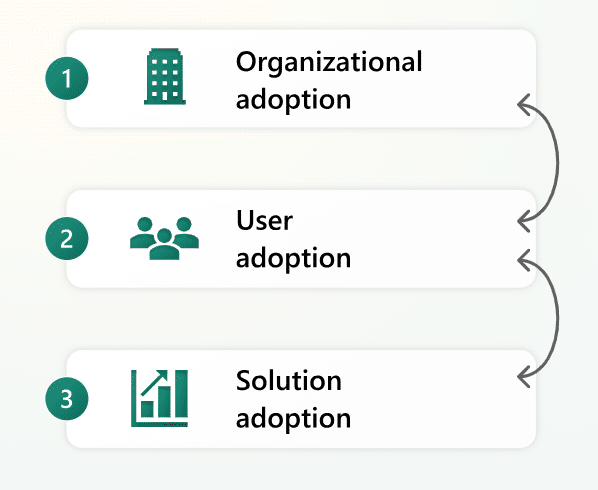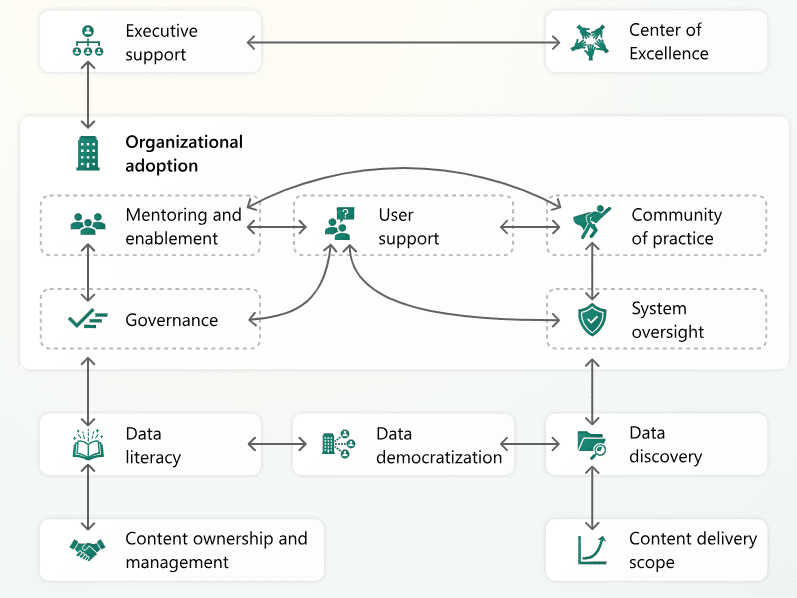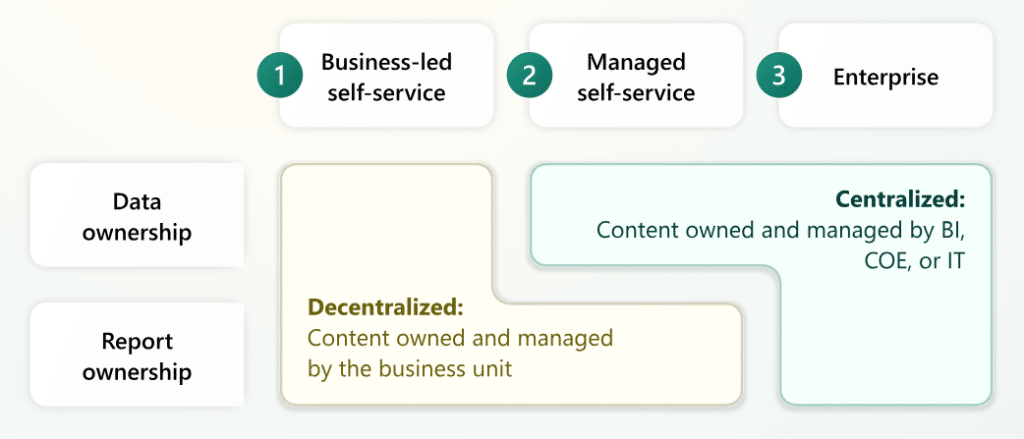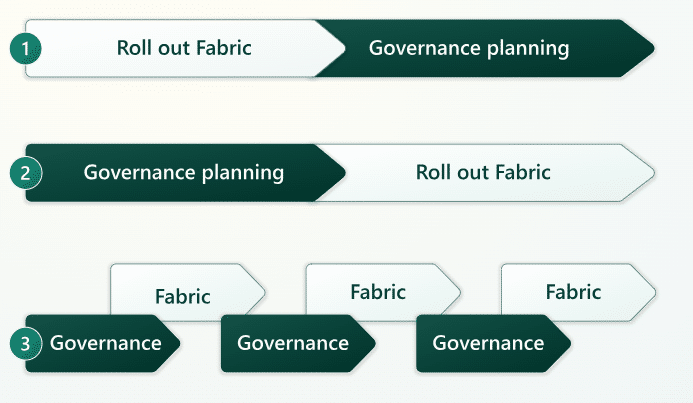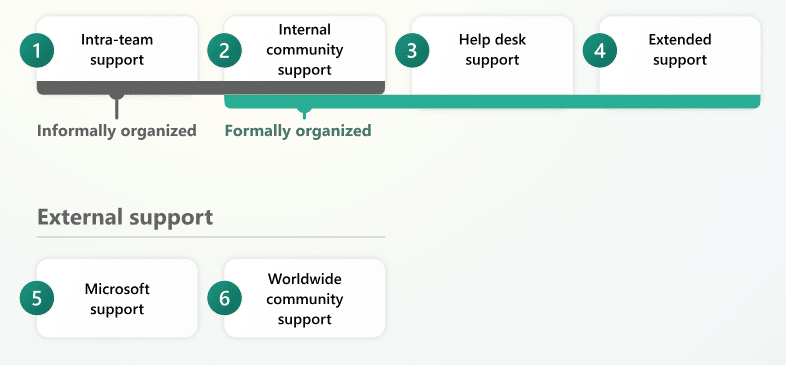Understanding the Microsoft Fabric Adoption Roadmap
Studying and deploying the Microsoft Fabric adoption roadmap can help you and your organization understand how to effectively implement this powerful new data management tool.
When implementing any new tool, there are a few key steps you need to follow to ensure it goes as smoothly as possible, including:
- Conducting an early assessment of your needs and goals
- Having early conversations with key stakeholders to get their feedback and gauge how they are feeling about implementing and using a new solution
- Establishing and planning a comprehensive training program
- Identifying the phases of your software solution rollout and how quickly you want it to go
- Setting up methods of tracking progress and measuring success
Having these key pillars in place as you prepare to implement a new solution like Fabric will help you uncover benefits, features, and functionalities that will improve your users' experiences and drive your business forward.
Is Your Business Ready? Follow the Microsoft Fabric Adoption Roadmap
Suppose you are considering Microsoft Fabric for your business. In that case, there is a step-by-step guide Microsoft has put together to make it easier to get your organization to adopt it. In this blog, we will break down each section of the adoption roadmap to help you prepare to implement this powerful data management solution.
Maturity Levels
There are three main types of adoption you need to understand to implement Microsoft Fabric effectively.
Each section has its own set of “maturity levels”, which you can use to help track progress on how your overall adoption is going.
Organizational Adoption
Organizational adoption measures the state of analytics governance and data management practices, with goals such as supporting users, empowering them, and overseeing information delivery through continuous improvement.
- Maturity Level 100 – Initial: This is a starting point where your users are new to Fabric and don’t have any experience or process knowledge.
- Maturity Level 200 – Repeatable: Also referred to as the “managed” level, at this point users execute data management. Although, this level of knowledge is likely not applied uniformly throughout the organization.
- Maturity Level 300 – Defined: At this point in the process, you have established data management processes and they are consistent across your organization.
- Maturity Level 400 – Capable: Also known as “measured”, at this point data management is optimized throughout its life cycle.
- Maturity Level 500 – Efficient: You’ve now reached a level where optimized data management is in place across your organization, and you’ve moved on to identifying opportunities for automation and continuous improvement.
You should aim for at least a maturity level of 300 or 400 to maximize your analytics investment.
User Adoption
User adoption measures how prepared your users are to use Microsoft Fabric. There are four main stages:
- Awareness: Users have knowledge of data analytics and might have access to Fabric but aren’t using it yet.
- Understanding: Your team members understand the value of data analytics and how tools like Fabric support decision-making and start using it.
- Momentum: Team members gain basic competency and skills through formal training, self-directed learning, and experimentation in Fabric.
- Proficiency: Users now use Fabric regularly, understand and champion data analytics, and make efforts to improve their skills and stay up to date.
Getting your users on board is a top priority when implementing a new solution.
Solution Adoption
Solution adoption measures the impact Fabric has on your organization once it has been deployed. There are four phases:
- Exploration: Your users will test the new solution to make sure it’s all working on optimized processes. You will then collect feedback to optimize.
- Functional: The solution now meets basic requirements for users and all necessary pieces are in place. This might be a limited release.
- Valuable: Your organization, and the users who use Fabric, are now seeing the benefits of the solution, which has been branded and personalized.
- Essential: Target users routinely use Fabric in your organization and it is considered an essential decision-making tool. Users provide feedback regularly and expectations are set and measured.
Maturity levels interweave throughout the remaining steps in the Fabric adoption roadmap and serve as markers of success.
Data Culture
Building a data culture is integral to adopting analytics and is often a key aspect of digital transformation. Data culture, defined as a set of behaviors and norms in an organization, encourages informed data decision-making based on analytics rather than opinion, using best practices approved by a Center of Excellence (COE).
Data culture is not just a set of rules but the behaviors and norms encouraged and rewarded within the organization. While technology can advance data culture goals, the focus should be on the behaviors that drive data use, ensuring stakeholders at all levels demonstrate the importance of data through their actions.
Executive Sponsorship
An executive sponsor and strong executive support are vital because analytics adoption transcends technology projects, involving strategic vision, goal-setting, and resource allocation. They must also be involved in decision-making, dispute resolution, and supporting organizational change initiatives.
Executive sponsors can be identified through top-down or bottom-up approaches:
- In the top-down approach, senior executives appoint a Chief Data Officer or another senior leader to advance data culture objectives.
- Conversely, the bottom-up approach sees leaders who have succeeded in smaller-scale data initiatives emerge as potential sponsors.
While the top-down method is generally more successful due to formal authority, the bottom-up approach can also be effective if recognized and supported by senior leadership.
Business Alignment
Business intelligence (BI) activities and solutions are most valuable when aligned with organizational business goals. Effective business alignment improves adoption by enabling business users to achieve their objectives.
The benefits of effective business alignment include improved adoption, increased ROI for analytics initiatives, and reduced change management efforts due to a better understanding of business data needs.
Achieving business alignment involves effective communication, strategic planning, and executive engagement and alignment. Maintaining business alignment is a continual process involving feedback mechanisms, success measurement, and regular re-alignment sessions.
Content Ownership
There are three primary strategies for managing data, analytics, and BI content: business-led self-service, managed self-service, and enterprise. These strategies are influenced by an organization's data culture and involve different levels of responsibility and control.
- Business-led self-service, or decentralized strategy, has content owned by creators within business units.
- Managed self-service involves a centralized team managing data while business users handle reports and dashboards, blending central discipline with flexibility.
- Enterprise strategy centralizes all content management within a team like IT or the COE. Organizations rarely stick to one strategy exclusively, often using a mix depending on factors such as solution requirements, user skills, training commitment, flexibility, complexity, and leadership priorities.
The choice of strategy significantly impacts governance levels, with business-led self-service having the least stringent controls, managed self-service with moderate controls, and enterprise solutions with the most rigorous controls.
Content Delivery Scope
The four delivery scopes for data and business intelligence (BI) solutions—personal, team, departmental, and enterprise—affect content distribution, management, security, and information protection.
- Personal scope targets individual use
- Team scope involves close collaboration among colleagues
- Departmental scope caters to larger groups within a department, requiring formal content delivery and management.
- Enterprise scope delivers content across organizational boundaries, managed by a centralized team with stringent governance requirements.
These scopes also influence governance requirements, mentoring, user support, and licensing decisions.
Center of Excellence
A data or analytics Center of Excellence (COE) is an internal team of technical and business experts that assists others within the organization in working with data, advancing adoption goals, and aligning with the data culture vision. Having a COE team formally recognized in the organizational chart is recommended but not required, as the critical aspect is identifying, prioritizing, and assigning COE roles and responsibilities.
The scope of COE responsibilities varies significantly but commonly includes:
- Mentoring
- Holding office hours
- Conducting co-development projects
- Managing portals
- Producing training materials
- Creating documentation
- Applying governance guidelines.
Governance
Data governance is a broad and complex topic focusing primarily on user behavior with data rather than the data itself. It involves decision rights, accountabilities, and processes to manage data effectively within an organization. Key goals include user empowerment, regulatory compliance, and adherence to internal requirements, which balance control and empowerment.
Governance strategies can be implemented in various ways, such as rolling out data platforms like Microsoft Fabric first and introducing governance later, conducting in-depth governance planning before platform rollout, or iteratively planning and rolling out the platform.
Mentoring and User Enablement
Mentoring can take various forms, including office hours, co-development projects, and best practices reviews. Office hours provide ongoing community engagement where users can seek assistance from COE experts and peers, ensuring questions are answered, problems are solved, and blockers are removed efficiently. Best practice reviews help validate and improve self-service Fabric content, ensuring adherence to organizational standards.
A centralized portal or hub is essential for user enablement, providing access to community Q&A forums, training materials, documentation, governance guidance, report templates, and more. Overall, consistent communication, regular updates, and comprehensive training and documentation support are vital for fostering a self-sustaining and proficient user community.
Community of Practice
A community of practice brings together individuals with a common interest, such as using Microsoft Fabric for effective analytics, to voluntarily support and help each other.
The community's success relies on fostering knowledge sharing through various activities like discussion channels, lunch and learn sessions, and internal conferences. Effective communication is key, with regular updates and feedback mechanisms to ensure that all members are informed and engaged.
User Support
Setting up an internal support solution like a help desk is a key step in helping your users with questions they have about Fabric. The help desk handles formal requests, particularly from less experienced users, and extended support involves a specialized team managing complex issues. External support includes Microsoft support and the broader community of experts, offering additional resources and documentation.
Internal support can be complemented by external options, including Microsoft documentation and worldwide community forums.
System Oversight
System oversight, also known as Fabric administration, encompasses the day-to-day management activities crucial for ensuring effective governance, user empowerment, and broad adoption of the Fabric platform.
Fabric administrators handle a wide range of responsibilities, including overseeing tenant settings, managing workspaces, and integrating with Azure services. They play a key role in managing capacity, data architecture, and data gateways, all while balancing user empowerment with governance.
Change Management
When aiming to enhance data and business intelligence (BI) adoption, effective change management is essential. This involves implementing procedures that address the impact of changes on people within an organization to prevent disruption and productivity loss. For instance, when migrating to Power BI, managing change effectively can boost adoption and productivity by helping users adapt to new tools sooner, reducing redundancy, and minimizing risk behaviors. It also involves mitigating resistance and stress by fostering clear communication and empathetic engagement with the affected individuals.
Change management encompasses various levels, from process-level to solution-level changes.
- Process-level changes might include shifts in ownership structures or the transition from static reports to interactive analytics
- Solution-level changes, on the other hand, might involve alterations in calculation logic or data presentation.
An incremental approach to implementing change, starting with high-priority modifications and breaking them into manageable phases, can ease the transition.
Want to Learn More About Optimizing Your Organization’s Adoption of Microsoft Fabric?
Get in touch with our team at Stoneridge! We can help your organization prepare to implement Fabric and use it to optimize your data management and business intelligence processes.
Under the terms of this license, you are authorized to share and redistribute the content across various mediums, subject to adherence to the specified conditions: you must provide proper attribution to Stoneridge as the original creator in a manner that does not imply their endorsement of your use, the material is to be utilized solely for non-commercial purposes, and alterations, modifications, or derivative works based on the original material are strictly prohibited.
Responsibility rests with the licensee to ensure that their use of the material does not violate any other rights.





